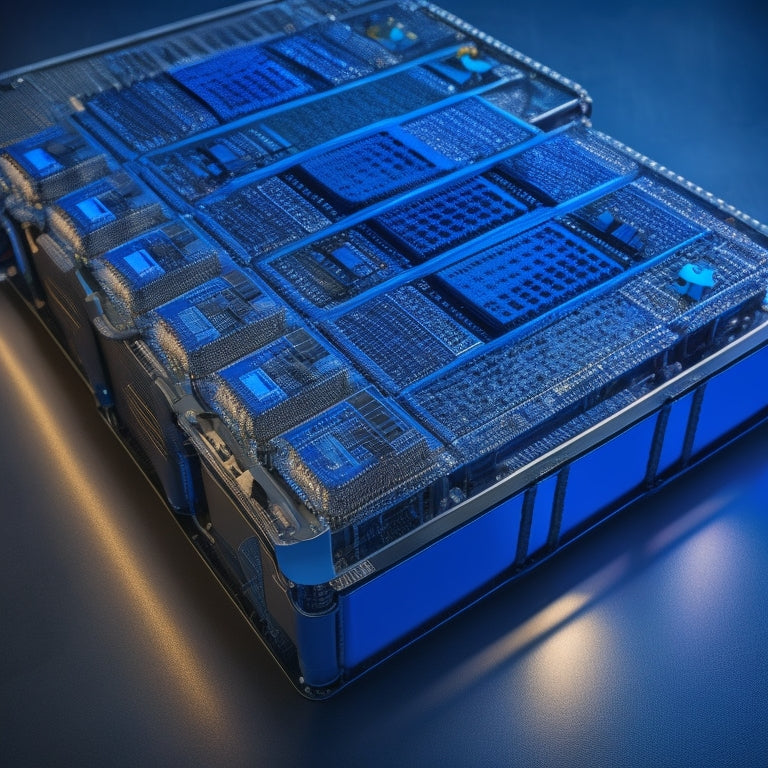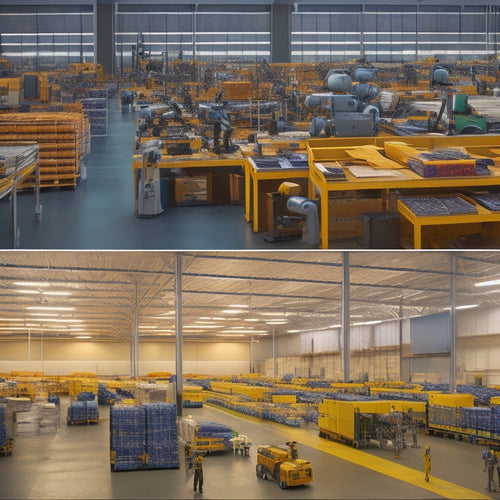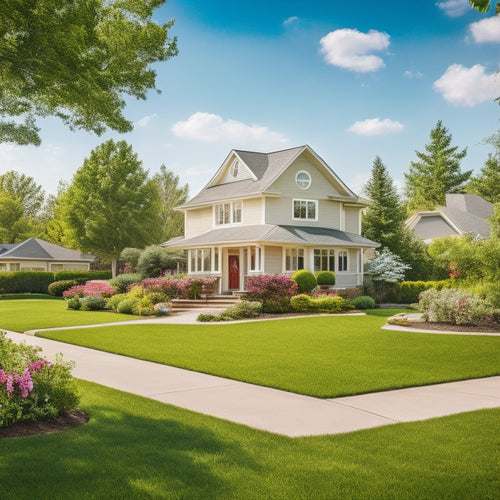
Advanced EV Battery Packs for High Capacity Needs
Share
You're working on advanced EV battery packs that require high-capacity energy storage, and you know that careful consideration of key design principles, advanced cell chemistry options, and effective thermal management strategies is vital. You'll need to prioritize key principles for maximum energy storage, select a well-designed electrical architecture, and choose the right battery management system. Advanced cell chemistry options like high-nickel NMC cathodes and solid-state electrolytes can enhance performance. Next, you'll want to implement thermal management strategies, high-power charging capabilities, and smart battery management systems. As you explore these complexities, you'll uncover the nuances of advanced EV battery packs, and the possibilities will start to take shape.
Key Takeaways
• Advanced cell chemistry options like high-nickel NMC cathodes and lithium-rich cobalt-based cathodes enhance energy density and cycle life in EV battery packs.
• Implementing a well-designed electrical architecture and power electronics components enables high-capacity energy storage and efficient power delivery.
• Effective thermal management strategies, including heat sinks, air-cooling, and liquid-cooling systems, optimize battery performance and longevity.
• Advanced battery management systems (BMS) with predictive analytics and real-time monitoring ensure peak performance, safety, and longevity in high-capacity EV battery packs.
• Solid-state electrolytes offer enhanced safety, higher energy density, and improved power density, making them a promising technology for advanced EV battery packs.
High-Capacity Battery Design Principles
When designing high-capacity battery packs, you must prioritize several key principles to guarantee maximum energy storage and efficient power delivery. A well-designed electrical architecture is vital, as it enables the best allocation of power and energy resources. This involves selecting the right battery management system, power electronics, and thermal management components to ensure seamless communication and efficient energy flow.
Scalability is another critical aspect, as it allows you to increase or decrease the battery pack's capacity according to your specific needs. A scalable design enables you to adapt to changing requirements, making it an essential consideration in high-capacity battery design.
Advanced Cell Chemistry Options
You can further enhance your high-capacity battery pack's performance by exploring advanced cell chemistry options that offer improved energy density, power density, and cycle life.
By adopting innovative cell architectures, you can access additional energy storage capacity and enhance overall pack efficiency. For instance, adopting a nested or spiral cell design can boost energy density by up to 20%.
Additionally, advanced electrolyte formulations can greatly improve power density and cycle life. You can consider using high-nickel NMC (nickel-manganese-cobalt) cathodes, which offer enhanced energy density and power density. Alternatively, lithium-rich cobalt-based cathodes can provide higher energy density and longer cycle life.
Furthermore, solid-state electrolytes can replace traditional liquid electrolytes, enhancing safety and energy density. By carefully selecting and integrating these advanced cell chemistry options, you can create a high-capacity battery pack that meets the demands of your EV application.
Thermal Management Strategies
Optimize your battery pack's thermal performance by employing advanced thermal management strategies that regulate operating temperatures, mitigate thermal runaway risks, and enhance overall pack reliability. You can achieve this by incorporating heat sinks, which dissipate heat efficiently, reducing the risk of thermal runaway.
Heat sinks with optimized fluid dynamics promote uniform heat dissipation, preventing hotspots that can lead to battery degradation. To maximize heat transfer, consider using advanced materials with high thermal conductivity, such as graphite or copper. These materials can be integrated into the heat sink design to enhance heat dissipation.
Additionally, you can employ air-cooling or liquid-cooling systems to further reduce temperatures. In liquid-cooling systems, fluid dynamics play a critical role in ensuring efficient heat transfer. By optimizing the flow rate, pressure drop, and heat transfer coefficient, you can maximize heat dissipation and maintain the best operating temperatures.
High-Power Charging Capabilities
High-power charging capabilities in advanced EV battery packs rely on sophisticated charging algorithms and high-current electrical architectures to rapidly replenish energy stores. As you explore the world of electric vehicles, you'll realize that rapid recharging is essential for widespread adoption. This is where high-power charging capabilities come into play, enabling you to quickly top up your battery on the go.
| Charging Method | Charging Speed |
|---|---|
| Level 2 (240V) | 3-4 hours for 80% charge |
| DC Fast Charging | 30-45 minutes for 80% charge |
| Tesla Supercharger | 45-60 minutes for 80% charge |
| High-Power Charging | 15-30 minutes for 80% charge |
With the growth of charging infrastructure, you can now charge your EV rapidly, reducing range anxiety and making long road trips a breeze. High-power charging capabilities are becoming increasingly common, with many manufacturers incorporating this technology into their EVs. As the charging infrastructure continues to expand, you can expect even faster charging speeds, making EVs an increasingly viable option for daily driving.
Smart Battery Management Systems
As you explore the world of advanced EV battery packs, you'll find that sophisticated smart battery management systems (BMS) play an essential role in ensuring peak performance, safety, and longevity.
Advanced EV battery packs rely on sophisticated smart battery management systems (BMS) to monitor and control key battery parameters, ensuring peak performance, safety, and longevity. These systems use real-time monitoring to track essential signs such as state of charge, voltage, and temperature, allowing for precise control and optimization.
With predictive analytics, the BMS can forecast battery behavior, anticipating potential issues before they arise. This enables proactive measures to prevent overheating, overcharging, or other malfunctions that could compromise battery health.
By leveraging real-time data and advanced algorithms, the BMS can fine-tune charging and discharging rates, maximizing energy efficiency and extending the battery's lifespan.
As you explore the world of EV battery packs, it's clear that smart BMS is the backbone of a reliable, high-performance battery system.
High-Energy Density Materials
As you delve into the world of high-energy density materials, you'll discover three key areas that are revolutionizing EV battery packs.
You'll find that lithium-rich materials are pushing the boundaries of energy storage, while nanostructured cathodes are optimizing electron transfer.
Meanwhile, solid-state electrolytes are redefining the safety and performance of EV batteries.
Lithium Rich Materials
You're likely familiar with the increasing demand for advanced EV battery packs, which has driven researchers to explore lithium-rich materials that boast high-energy density, promising to greatly enhance electric vehicle performance and range. These materials have taken center stage in the quest for high-capacity EV batteries.
Lithium-rich materials, characterized by their high lithium content, exhibit exceptional material properties, such as high discharge capacity and impressive cycle life. These properties make them ideal for EV applications where energy density and power density are paramount.
When it comes to sourcing lithium, researchers are exploring innovative methods to reduce environmental impacts and increase supply chain efficiency. Sourcing lithium from hard rock mining, brine extraction, and even recycling lithium-ion batteries are some of the strategies being explored.
Nanostructured Cathodes
Researchers are now focusing on nanostructured cathodes, a class of high-energy density materials that exhibit exceptional power density and cyclability, making them a promising solution for advanced EV battery packs.
You're likely wondering how these materials achieve such impressive performance. The key lies in their unique nanostructure, which enables a notably larger nano surface area. This increased surface area allows for more efficient lithium-ion transport, leading to enhanced power density and stability.
In fact, studies have shown that nanostructured cathodes can demonstrate up to 30% higher energy density compared to traditional cathode materials. Moreover, the improved cathode stability also leads to extended cycle life, making them an attractive option for high-capacity EV battery packs.
As you explore the potential of nanostructured cathodes, you'll discover that their unique properties make them an essential component in the development of advanced EV battery packs. By leveraging these materials, you can access higher energy density, longer cycle life, and improved overall performance.
Solid-State Electrolytes
By further optimizing the battery's internal components, you can now focus on solid-state electrolytes, a class of high-energy density materials that offer enhanced safety, energy density, and power density compared to traditional liquid electrolytes. These solid-state electrolytes are poised to revolutionize electric vehicle (EV) battery technology, enabling greater range and faster charging times.
You'll find that solid-state electrolytes demonstrate improved electrochemical stability, owing to their ability to suppress lithium dendrite growth and prevent thermal runaway. Ionic liquids, a type of solid-state electrolyte, have shown particular promise in this regard. By leveraging these materials, you can develop batteries that aren't only safer but also more energy-dense, allowing for more efficient electric vehicles.
In the pursuit of high-capacity EV batteries, solid-state electrolytes are a critical component. By harnessing their unique properties, you can access new levels of performance and efficiency.
As you explore further into the world of advanced EV battery packs, it's crucial to grasp the significance of solid-state electrolytes and their role in shaping the future of electric mobility.
Advanced Battery Cooling Systems
When designing advanced battery cooling systems, you'll need to explore thermal management strategies that optimize heat dissipation.
You'll explore cooling system designs that minimize thermal resistance and maximize heat transfer, such as air-cooled and liquid-cooled systems.
Your choice of heat exchanger materials will also be critical, as they'll impact the system's overall efficiency and reliability.
Thermal Management Strategies
What thermal management strategies can you employ to prevent your EV battery pack from overheating, a scenario that can drastically reduce its lifespan and overall performance? Effective thermal management is important to maintain ideal battery operation, especially during high-discharge rates or extreme ambient temperatures.
To mitigate thermal issues, consider the following strategies:
-
Temperature Gradients: Monitor and control temperature differences within the pack to prevent hotspots and maintain uniform heat distribution.
-
Cooling Pathways: Design efficient cooling pathways to facilitate heat transfer and minimize thermal resistance.
-
Airflow Management: Optimize airflow within the pack to enhance convective cooling and reduce temperature gradients.
-
Phase Change Materials: Integrate phase change materials to absorb and release heat, stabilizing battery temperature.
-
Advanced Materials: Select materials with high thermal conductivity to enhance heat transfer and reduce thermal gradients.
Cooling System Designs
In order to guarantee efficient heat dissipation, you'll need to design a cooling system that can effectively manage the thermal load of your EV battery pack, particularly during high-discharge rates or extreme ambient temperatures. This requires a deep understanding of fluid dynamics, as the cooling system's design must secure ideal fluid flow and heat transfer.
One effective approach is to incorporate heat sinks into the design, which can greatly enhance heat dissipation. By strategically placing heat sinks in close proximity to the battery cells, you can create a more efficient thermal management system.
Additionally, the cooling system's design should account for the battery pack's specific thermal characteristics, such as its thermal conductivity and specific heat capacity. By considering these factors, you can create a cooling system that efficiently handles the thermal load, ensuring reliable and efficient operation of your EV battery pack.
Heat Exchanger Materials
You'll need to select heat exchanger materials that can efficiently transfer heat, minimize pressure drop, and resist corrosion, while also meeting the stringent requirements of advanced battery cooling systems. This is essential for maintaining ideal operating temperatures and guaranteeing the reliability of your EV battery packs.
When choosing heat exchanger materials, consider the following key factors:
-
Microchannel design: Incorporate microchannels to increase heat transfer surface area and enhance heat transfer efficiency.
-
Thermal conductivity: Select materials with high thermal conductivity to facilitate efficient heat transfer.
-
Corrosion resistance: Ensure the material can withstand the corrosive effects of coolant fluids and environmental factors.
-
Nanofluid applications: Explore the potential of nanofluids to enhance heat transfer performance and reduce pressure drop.
-
Cost and manufacturability: Balance material selection with production costs and manufacturing feasibility.
Increased Range and Efficiency
By integrating advanced battery management systems, electric vehicle manufacturers can squeeze out more miles from each charge, boosting overall range and efficiency. You'll notice significant improvements in range optimization, as these systems expertly regulate energy distribution, minimizing waste and maximizing output.
Energy harvesting technology also plays a pivotal role, capturing kinetic energy generated by the vehicle's movement and converting it into electrical energy, further extending your driving range. This synergy of advanced technologies enables electric vehicles to travel farther on a single charge, alleviating range anxiety and making EVs a more viable option for daily driving.
As you take advantage of these cutting-edge innovations, you'll experience the thrill of driving an EV that's both eco-friendly and high-performance. With increased range and efficiency, the possibilities for electric vehicles become endless, and the future of sustainable transportation looks brighter than ever.
Customizable Battery Pack Solutions
Your electric vehicle's battery pack can be tailored to meet specific performance, range, and design requirements with customizable battery pack solutions that offer unparalleled flexibility. This means you can optimize your battery pack to fit your unique needs, whether that's maximizing range, improving efficiency, or achieving a specific power output.
Here are just a few ways customizable battery pack solutions can benefit your EV:
-
Modular designs allow for easy scalability and adaptability, making it simple to upgrade or modify your battery pack as needed.
-
With packaging options tailored to your vehicle's specific design, you can optimize space and reduce weight, improving overall performance.
-
Customizable battery packs enable precise control over temperature management, ensuring ideal operating conditions and extending battery lifespan.
-
You can also choose from a range of cell chemistries to suit your specific application, from high-energy density to high-power density.
-
Finally, customizable battery packs can be designed with integrated safety features, providing an added layer of protection for passengers and the vehicle itself.
Integration With Vehicle Systems
The advanced battery management system (BMS) seamlessly integrates with your vehicle's onboard systems, guaranteeing peak performance, reliability, and safety. This integration enables real-time vehicle communication, allowing your vehicle to optimize its systems for maximum efficiency. You can expect enhanced performance, improved fuel economy, and reduced emissions.
The BMS optimizes system performance by continuously monitoring and controlling various parameters such as temperature, voltage, and current. This ensures that your vehicle operates within a safe and efficient range, reducing the risk of overheating, overcharging, or electrical faults.
By integrating with your vehicle's onboard systems, the BMS enables advanced features like regenerative braking, which captures kinetic energy and converts it into electrical energy, further improving fuel efficiency.
The advanced BMS also facilitates system optimization by providing real-time data and analytics, enabling you to fine-tune your vehicle's performance and make data-driven decisions. With advanced vehicle communication and system optimization, you can harness the full potential of your electric vehicle, enjoying a smoother, more efficient, and more enjoyable driving experience.
Frequently Asked Questions
Can Advanced EV Battery Packs Be Retrofitted Into Older Vehicles?
When considering retrofitting advanced EV battery packs into your older vehicle, you'll face challenges like vehicle compatibility issues and complex upgrade hurdles, necessitating thorough analysis to guarantee smooth integration and peak performance.
How Do High-Capacity Battery Packs Impact Vehicle Insurance Rates?
As you consider upgrading to high-capacity battery packs, you'll face increased insurance premiums due to heightened risk assessment, potentially leading to premium hikes, as insurers factor in the added cost of replacing these advanced, pricey components.
Are Advanced EV Battery Packs More Prone to Overheating?
You might recall Tesla's 2013 thermal runaway incident; thankfully, advanced cell protection and thermal management systems minimize overheating risks, ensuring your EV battery pack operates within a safe temperature range, even during high-demand driving.
Can Advanced EV Battery Packs Be Recycled at End-Of-Life?
As you explore recycling options, you'll find that advanced EV battery packs can be recycled at end-of-life, with efficient battery collection systems and favorable recycling economics making it a viable, environmentally friendly choice.
Do Advanced EV Battery Packs Require Special Disposal Procedures?
'You'll need to follow strict disposal procedures to mitigate environmental risks, as advanced EV battery packs contain hazardous materials. Familiarize yourself with the regulatory framework and waste management guidelines to guarantee responsible disposal, avoiding harm to the ecosystem.'
Related Posts
-

Why Are Online Prices for Panels So Low?
When you buy panels online, you're often taking advantage of a combination of factors that drive prices lower. You're...
-

7 Best Financial Incentives for Residential Homeowners
You're entitled to a range of financial incentives that can help offset the costs of owning a home, from federal tax ...
-

5 Essential Tips for Your DIY Home Solar System
To guarantee a successful DIY home solar system installation, you'll need to assess your energy consumption, choosing...


